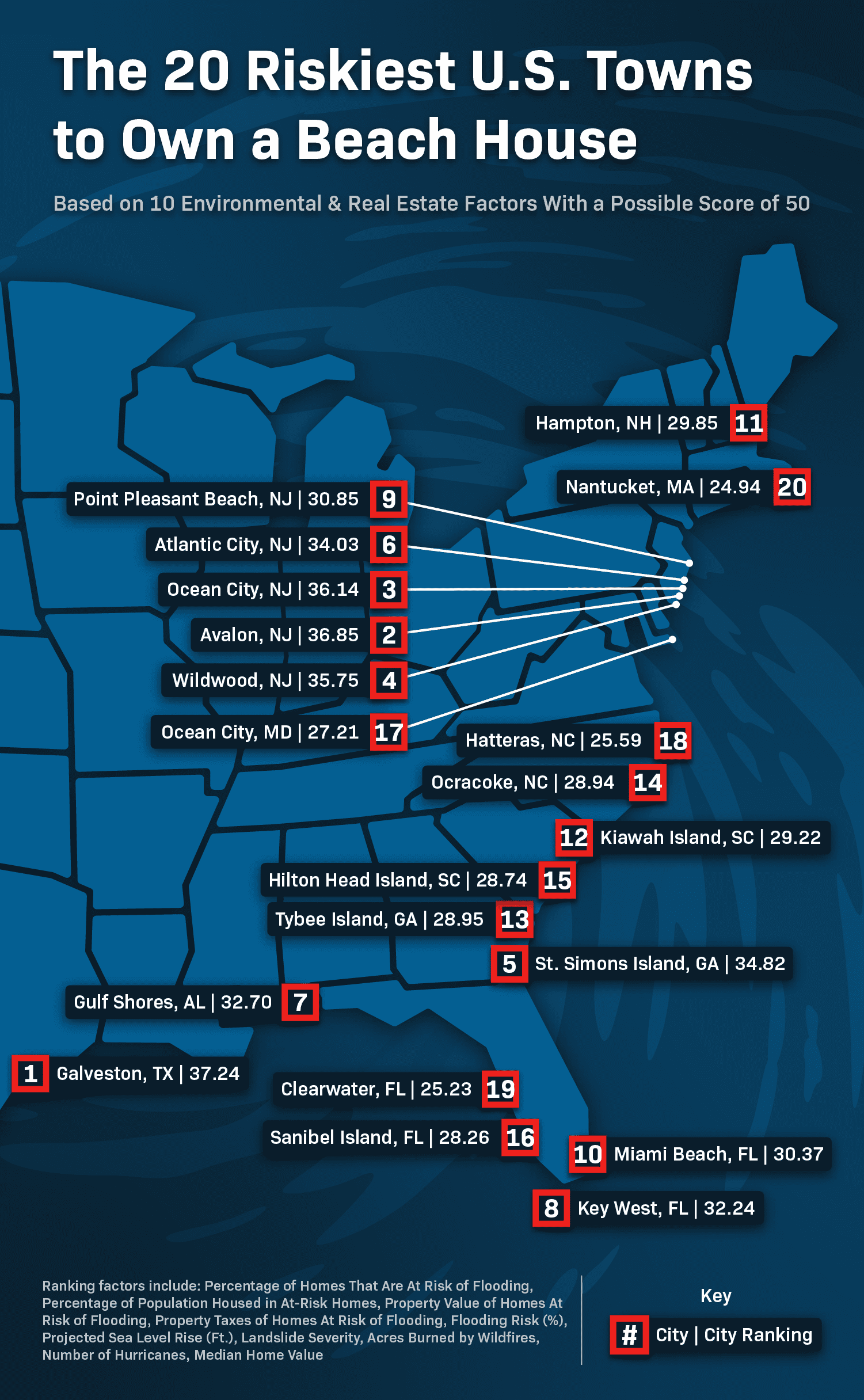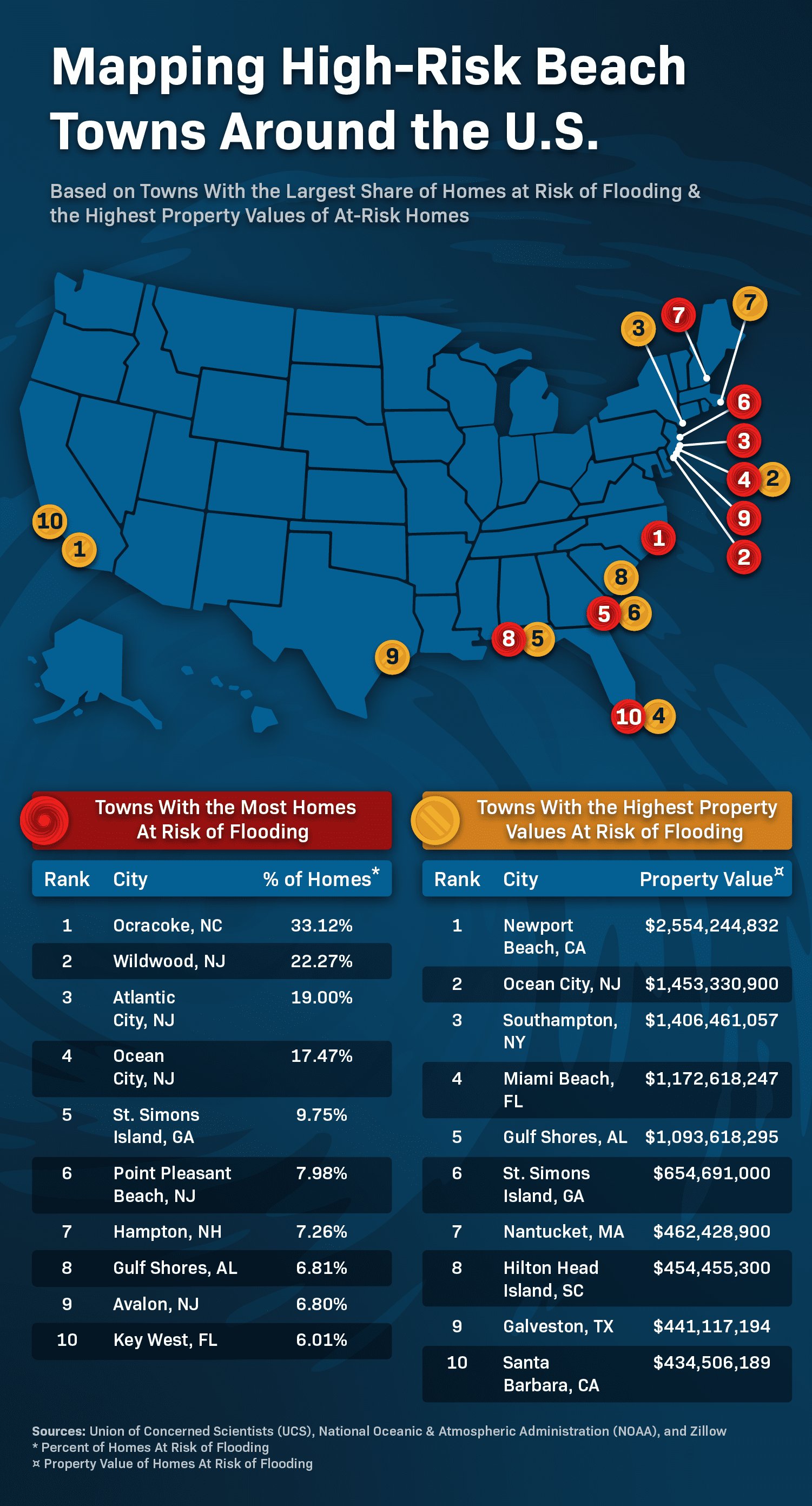As beach property values soar in 2023, many U.S. coastal residents are facing an increasingly urgent threat: rising sea levels and high-tide flooding. For those who own beach houses, this means their properties could be at risk of costly damage or even total loss. The risk is largely dependent on natural forces — meaning some cities are at higher risk than others.
We turned to data from the National Oceanic and Atmospheric Administration (NOAA), the Union of Concerned Scientists (UCS), and Zillow to rank 75 U.S. beach towns according to factors such as sea level rise, flood risk, property value, and more.
Beach homes need a comprehensive home insurance policy to protect against threats like storm damage and flooding due to rising sea levels. Home insurance can help protect homeowners from the high costs of unexpected repairs and losses. But without adequate coverage, beach property owners may find themselves facing devastating losses in the event of a natural disaster. While home insurance does cover storm damage, homeowners without stand-alone flood policies may not be covered if flooding occurs.
By pairing our data analysis with the right insurance coverage, beach property owners can enjoy the benefits of their investment while minimizing their risk. Dive in and uncover the riskiest towns to own a beach house — and how insurance can help keep your property safe.
Key Findings
- Galveston, TX is the riskiest town in our study to own a beach house. Galveston’s sea level is projected to rise 1.9 feet by 2040 — 58.3% higher than the national average. What’s more, the property value of Galveston’s homes at risk of flooding is $441,117,194.
- Jersey Shore beach towns dominate the top 10 riskiest towns. Many Jersey Shore towns have a projected sea level rise of 1.6 feet by 2040 — 33% higher than the national average.
- Southern beach towns make up half of the top 20. Out of the top 20 ranked towns, four are in Florida, another four are in low-country towns spanning South Carolina and Georgia, and the remaining two are in North Carolina’s Outer Banks.
The 20 Riskiest U.S. Towns to Own a Beach House

Owning a beach house can come with significant risks and challenges, particularly in the face of rising sea levels and natural disasters. Galveston, TX, in particular, has some of the most valuable at-risk beach homes at a total value of $441,117,194. Galveston stands out as the riskiest town to own a beach house due to its high projected sea level rise by 2040 of 1.9 feet — 58.3% higher than the national average.
Several Jersey Shore beach towns show significant flood risks and property values at risk of damage. The combined property value of Ocean City, NJ’s homes at risk of flooding is $1,453,330,900. Over 22% of homes in Wildwood, NJ, are at risk of flooding — the second highest in our study. And Avalon, NJ’s flood risk is 98%. Jersey Shore towns have a projected sea level rise of 1.6 feet by 2040 — 33% higher than the national average.
In addition to New Jersey, several low-country towns in Georgia and South Carolina also rank in the top 20 riskiest towns. St. Simon’s, GA, which ranks #5, and Kiawah, SC, which ranks #12, are both located outside of major cities and face the challenges of rising sea levels and coastal erosion. Tybee Island, located outside of Savannah, ranks #13, and Hilton Head, SC, ranks #15, further highlighting the risks that coastal towns in the Southeast face.
While many things are out of a homeowner’s control, beach property owners can take proactive measures to protect their investment, such as elevating properties, reinforcing foundations, and creating natural barriers to mitigate the impact of rising sea levels and high-tide flooding.
Ultimately, while owning a beach house can be a dream for many, it’s important to be aware of the risks and take steps to protect your investment. By understanding the data and taking a proactive approach, beach property owners can enjoy the benefits of their investment while minimizing the potential for damage and loss.
Beach Towns With the Most At-Risk Homes & Property Values

Ocracoke, NC has the highest percentage of at-risk beach homes at 33.12%.This small town is located on the Outer Banks of North Carolina, which is a narrow chain of barrier islands that is constantly threatened by hurricanes and rising sea levels.
Newport Beach, CA, has the highest property value of at-risk homes at $2,554,244,832. Newport Beach is home to some of California’s most affluent neighborhoods, meaning that not even the wealthiest areas are not immune to the threat of rising sea levels and high-tide flooding.
On the other side of the country, Ocean City, NJ ranks high on the list with two spots in the top 10. The town has a long history of flooding, and 17.47% of its homes are at risk. Hampton, NH also ranks high with 7.26% of its homes at risk, while Point Pleasant Beach, NJ has 7.98% at risk.
Moving down the list, St. Simons Island, GA comes in at #5 with 9.75% of its homes at risk. Located on the coast of Georgia, St. Simons Island is a popular tourist destination known for its beautiful beaches, golf courses, and historic landmarks.
Kiawah Island, SC comes in at #12 with 4.66% of its homes at risk, located outside of Charleston, SC, which is known for flooding. Tybee Island, located outside of Savannah, GA, ranks #13 with 4.24% of its homes at risk, and Hilton Head Island, SC comes in at #15 with 3.78% of its homes at risk. Each of these towns has unique characteristics that are attractive to visitors, but their location along the coast also puts their homes in a vulnerable position.
Closing Thoughts
In conclusion, owning a beach house can be a dream come true, but it’s important to consider the potential risks that come with it. Our analysis of the 75 most popular beach towns in America highlights the towns with the highest risk factors, including projected sea level rise, the number of homes at risk of flooding, and property values of homes at risk.
Galveston, TX, and several Jersey Shore towns, dominated the top of the list, while other beach towns in Florida, North Carolina, South Carolina, and Georgia also faced significant risks. It’s crucial for beach property owners to protect their investment with comprehensive home and flood insurance policies that covers threats like storm damage and flooding due to rising sea levels. Assurance IQ can help beach property owners find the right home insurance policy to safeguard their homes.
Methodology
In order to evaluate risk of beach towns across the U.S., we started with a list of 75 of the most populous beach towns. From there, we analyzed data across 10 unique ranking factors. We assigned cities with a score of 0-5 for each factor, with a score of 5 representing the most favorable conditions. We determined each city’s total score from the total of its individual factor scores, which were weighted according to their impact on the risk associated with owning a beach house. Individual factor scores were then added together to give each city a final score from 0-50. Higher scores indicated cities are more at risk to own a beach house. A complete list of ranking factors can be found below.
Percentage of Homes That Are At Risk of Flooding
- Weight: 1.50
- Source: UCS
Percentage of Population Housed in At-Risk Homes
- Weight: 1.25
- Source: UCS
Property Value of Homes At Risk of Flooding
- Weight: 1.00
- Source: UCS
Property Taxes of Homes At Risk of Flooding
- Weight: 0.50
- Source: UCS
Flooding Risk (%)
- Weight: 1.25
- Source: Climate Central
Projected Sea Level Rise (ft.)
- Weight: 1.25
- Source: Climate Central
Landslide Severity
- Weight: 0.50
- Source: USGS
Acres Burned by Wildfires
- Weight: 1.00
- Source: National Interagency Fire Center
No. of Hurricanes (1842-2021)
- Weight: 1.25
- Source: NOAA
Median Home Value
- Weight: 0.50
- Source: Zillow
